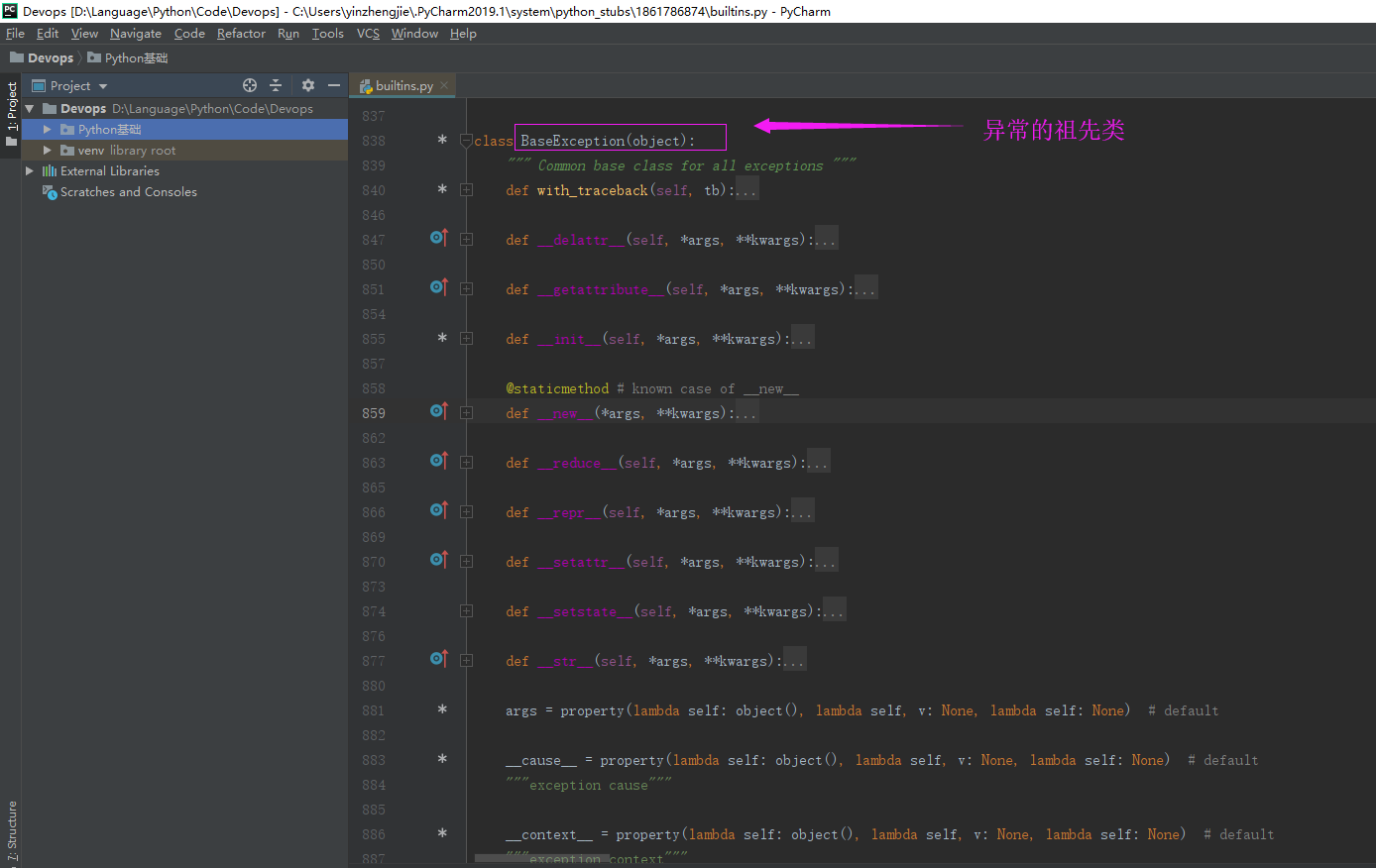Pthon面向对象-异常处理
作者:尹正杰
版权声明:原创作品,谢绝转载!否则将追究法律责任。
一.异常概述
1>.错误(Error)
逻辑错误:
算法写错了,例如加法写成了减法。
笔误:
例如变量名写错了,语法错误等。
函数或类使用错误,其实这也属于逻辑错误。
总之,错误时可以避免的。
2>.异常(Exception)
Exception本意就是意外情况。
这有个前提,没有出现上面说的错误,也就是说程序写的没有问题,但是在某种情况下,会出现一些意外,导致程序无法正常的执行下去。
例如open函数操作一个文件,文件不村咋子,或者创建一个文件时已经存在了,或者访问一个网络文件,突然断网了,这就是异常,是个意外的情况。
异常不可能避免。
3>.错误和异常
在高级编程这语言中,一般都有错误和异常的概念,异常时可以捕获,并被处理的,但是错误是不能被捕获的。
一个健壮的程序,尽可能的避免错误,尽可能的避免错误,尽可能的捕获,处理各种异常。
4>.产生异常
1 #!/usr/bin/env python 2 #_*_conding:utf-8_*_ 3 #@author :yinzhengjie 4 #blog:http://www.cnblogs.com/yinzhengjie 5 6 """ 7 raise语句显式的抛出异常,Python解释器自己检测到异常并引发它 8 """ 9 def foo(): 10 print("before") 11 raise Exception("my exception") # raise主动抛出异常,程序会在异常抛出的地方中断执行,如果不捕获,就会提前结束程序(其实是终止当前线程的执行) 12 print("after") 13 14 foo()
5>.异常的捕获
1 #!/usr/bin/env python 2 #_*_conding:utf-8_*_ 3 #@author :yinzhengjie 4 #blog:http://www.cnblogs.com/yinzhengjie 5 6 def foo(): 7 try: 8 print("before") 9 c = 1 / 0 #想必大家都知道在运行改行代码会引发"除零异常" 10 print("after") 11 except: #我们可以指定捕获的异常类型,如果不写默认捕获所有异常。 12 print("error") 13 14 print("catch the exception") 15 16 foo() 17 18 print("{0} 程序运行结束 {0}".format("*" * 20)) 19 20 21 22 #以上代码执行结果如下: 23 before 24 error 25 catch the exception 26 ******************** 程序运行结束 ********************
二.异常类及继承层次
1>.异常的祖先类(BaseException)

2>.通过"__subclasses__()"属性查看BaseException的子类
1 #!/usr/bin/env python 2 #_*_conding:utf-8_*_ 3 #@author :yinzhengjie 4 #blog:http://www.cnblogs.com/yinzhengjie 5 6 print(BaseException.__subclasses__()) 7 8 print(Exception.__subclasses__()) 9 10 print(RuntimeError.__subclasses__()) 11 12 print(ArithmeticError.__subclasses__()) 13 14 print(LookupError.__subclasses__()) 15 16 print(OSError.__subclasses__()) 17 18 19 20 21 #以上代码执行结果如下: 22 [<class 'Exception'>, <class 'GeneratorExit'>, <class 'SystemExit'>, <class 'KeyboardInterrupt'>] 23 [<class 'TypeError'>, <class 'StopAsyncIteration'>, <class 'StopIteration'>, <class 'ImportError'>, <class 'OSError'>, <class 'EOFError'>, <class 'RuntimeError'>, <class 'NameError'>, <class 'AttributeError'>, <class 'SyntaxError'>, <class 'LookupError'>, <class 'ValueError'>, <class 'AssertionError'>, <class 'ArithmeticError'>, <class 'SystemError'>, <class 'ReferenceError'>, <class 'MemoryError'>, <class 'BufferError'>, <class 'Warning'>, <class 'locale.Error'>] 24 [<class 'RecursionError'>, <class 'NotImplementedError'>, <class '_frozen_importlib._DeadlockError'>] 25 [<class 'FloatingPointError'>, <class 'OverflowError'>, <class 'ZeroDivisionError'>] 26 [<class 'IndexError'>, <class 'KeyError'>, <class 'encodings.CodecRegistryError'>] 27 [<class 'ConnectionError'>, <class 'BlockingIOError'>, <class 'ChildProcessError'>, <class 'FileExistsError'>, <class 'FileNotFoundError'>, <class 'IsADirectoryError'>, <class 'NotADirectoryError'>, <class 'InterruptedError'>, <class 'PermissionError'>, <class 'ProcessLookupError'>, <class 'TimeoutError'>, <class 'io.UnsupportedOperation'>]
三.自定义异常类
1 #!/usr/bin/env python 2 #_*_conding:utf-8_*_ 3 #@author :yinzhengjie 4 #blog:http://www.cnblogs.com/yinzhengjie 5 6 class MyException(Exception): 7 pass 8 9 try: 10 raise MyException() 11 except MyException: #捕获自定义异常 12 print("catch the exception") 13 14 15 16 #以上代码执行结果如下: 17 catch the exception
四.多种捕获
1 #!/usr/bin/env python 2 #_*_conding:utf-8_*_ 3 #@author :yinzhengjie 4 #blog:http://www.cnblogs.com/yinzhengjie 5 6 import sys 7 8 """ 9 捕获规则: 10 捕获是从上到下依次比较,如果匹配,则执行匹配的except语句块 11 如果被一个except语句捕获,其它except语句就不会再次捕获了 12 如果没有任何一个except语句捕获到这个异常,该异常向外抛出 13 如果"except:"称为缺省捕获,缺省捕获必须except捕获语句的最后。 14 15 捕获的原则: 16 从小到大,从具体到宽泛 17 """ 18 19 class MyException(Exception): 20 pass 21 22 try: 23 a = 1 / 0 24 raise MyException() 25 open("t") 26 sys.exit(1) 27 except ZeroDivisionError: 28 print("zero") 29 except ArithmeticError: 30 print("ari") 31 except MyException: #捕获自定义异常 32 print("catch the exception") 33 except Exception: 34 print("excption") 35 except: #缺省捕获 36 print("sys exit") 37 38 39 40 41 #以上代码执行几个如下: 42 zero
五.as子句
1 #!/usr/bin/env python 2 #_*_conding:utf-8_*_ 3 #@author :yinzhengjie 4 #blog:http://www.cnblogs.com/yinzhengjie 5 6 7 class MyException(Exception): 8 def __init__(self,code,message): 9 self.code = code 10 self.message = message 11 12 try: 13 """ 14 raise语句: 15 raise后要求应该是BaseException类的子类或实例,如果是类,将被无参实例化。 16 raise后上面都没有,表示抛出最近一个被激活的异常,如果没有被激活的异常,则抛出类型异常。这种方式很少用。 17 """ 18 raise MyException(200,"ok") 19 except MyException as e: 20 print("catch my exception: {} {}".format(e.code,e.message)) 21 except Exception as e: 22 print("{}".format(e)) 23 24 25 26 27 #以上代码执行几个如下: 28 catch my exception: 200 ok
六.finally子句
1 #!/usr/bin/env python 2 #_*_conding:utf-8_*_ 3 #@author :yinzhengjie 4 #blog:http://www.cnblogs.com/yinzhengjie 5 6 f = None 7 8 try: 9 f = open("test.txt") 10 except FileNotFoundError as e: 11 print("{} {} {}".format(e.__class__,e.errno,e.strerror)) 12 finally: 13 print("清理工作") 14 f.close()
七.else子句
1 #!/usr/bin/env python 2 #_*_conding:utf-8_*_ 3 #@author :yinzhengjie 4 #blog:http://www.cnblogs.com/yinzhengjie 5 6 try: 7 ret = 1 * 0 8 except ArithmeticError as e: 9 print(e) 10 else: #没有任何异常则执行 11 print("ok") 12 finally: 13 print("finally") 14 15 16 17 #以上代码执行结果如下: 18 ok 19 finally
八.总结
1>.语法格式
try: <语句> #运行别的代码 except <异常类>: <语句> #捕获某种类型的异常 except <异常类> as <变量名>: <语句> #捕获某种类的异常并获得对象 except: <语句> #缺省捕获 else: <语句> #如果没有异常发生才会执行 finally: <语句> #退出try时总会执行
2>.try的工作原理
如果try中语句执行时发生异常,搜索except子句,并执行第一个匹配该异常的except子句。
如果try中语句执行发生异常,却没有匹配的except子句,异常将被递交到外层的try,如果外层不处理这个异常,异常将继续向外层传递。如果都不处理该异常,则会传递到最外层,如果还没有处理,就终止异常所在的线程。
如果在try执行时没有发生异常,如有else子句,可执行else子句中的语句。
无论try中是否发生异常,finally子句最终都会执行。